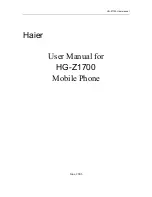
469
Appendix/Exter
nal De
vices/T
roub
leshooting
Continued
For more information on SAR, please refer to the safety chapter in the User’s Guide.
SAR data information for residents in countries that have adopted the SAR limit recommended
by the International Commission of Non-lonizing Radiation Protection (ICNIRP), which is 2 W/kg
averaged over ten (10) gram of tissue (for example European Union, Japan, Brazil and New
Zealand):
The highest SAR value for this model phone tested by Sony Ericsson for use at the ear is 1.01 W/kg
(10g).
Radio Frequency (RF) Exposure and SAR
Your mobile phone is a low-power radio transmitter and receiver.
When it is turned on, it emits low levels of radio frequency energy (also known as radio waves or
radio frequency fields).
Governments around the world have adopted comprehensive international safety guidelines,
developed by scientific organizations, e.g. ICNIRP (International Commission on Non-Ionizing
Radiation Protection) and IEEE (The Institute of Electrical and Electronics Engineers Inc.), through
periodic and thorough evaluation of scientific studies. These guidelines establish permitted levels
of radio wave exposure for the general population. The levels include a safety margin designed to
assure the safety of all persons, regardless of age and health, and to account for any variations in
measurements.
Specific Absorption Rate (SAR) is the unit of measurement for the amount of radio frequency
energy absorbed by the body when using a mobile phone. The SAR value is determined at the
highest certified power level in laboratory conditions, but the actual SAR level of the mobile phone
while operating can be well below this value. This is because the mobile phone is designed to use
the minimum power required to reach the network.
Variations in SAR below the radio frequency exposure guidelines do not mean that there are
variations in safety. While there may be differences in SAR levels among mobile phones, all Sony
Ericsson mobile phone models are designed to meet radio frequency exposure guidelines.
Before a phone model is available for sale to the public, it must be tested and certified to the
FCC that it does not exceed the limit established by the government-adopted requirement for
safe exposure. The tests are performed in positions and locations (that is, at the ear and worn
on the body) as required by the FCC for each model. For body worn operation, this phone has
been tested and meets FCC RF exposure guidelines when the handset is positioned a minimum
of 15 mm from the body without any metal parts in the vicinity of the phone or when used with the
original Sony Ericsson body worn accessory intended for this phone. Use of other accessories
may not ensure compliance with FCC RF exposure guidelines.
SAR information for this mobile phone model is included with the material that comes with this
mobile phone. This information can also be found, together with more information on radio
frequency exposure and SAR, on:
www.sonyericsson.com
Summary of Contents for FOMA SO905iCS
Page 50: ......
Page 94: ......
Page 108: ......
Page 206: ......
Page 254: ......
Page 382: ......
Page 478: ......
Page 479: ...477 Index Quick Manual Index 478 Quick Manual 490 ...
Page 489: ...MEMO ...
Page 490: ...MEMO ...
Page 491: ...MEMO ...
Page 530: ...Kuten Code List 08 1 Ver 1 A CUK 100 11 1 ...
Page 532: ...2 ...
Page 533: ...3 ...
Page 534: ...4 ...
















































